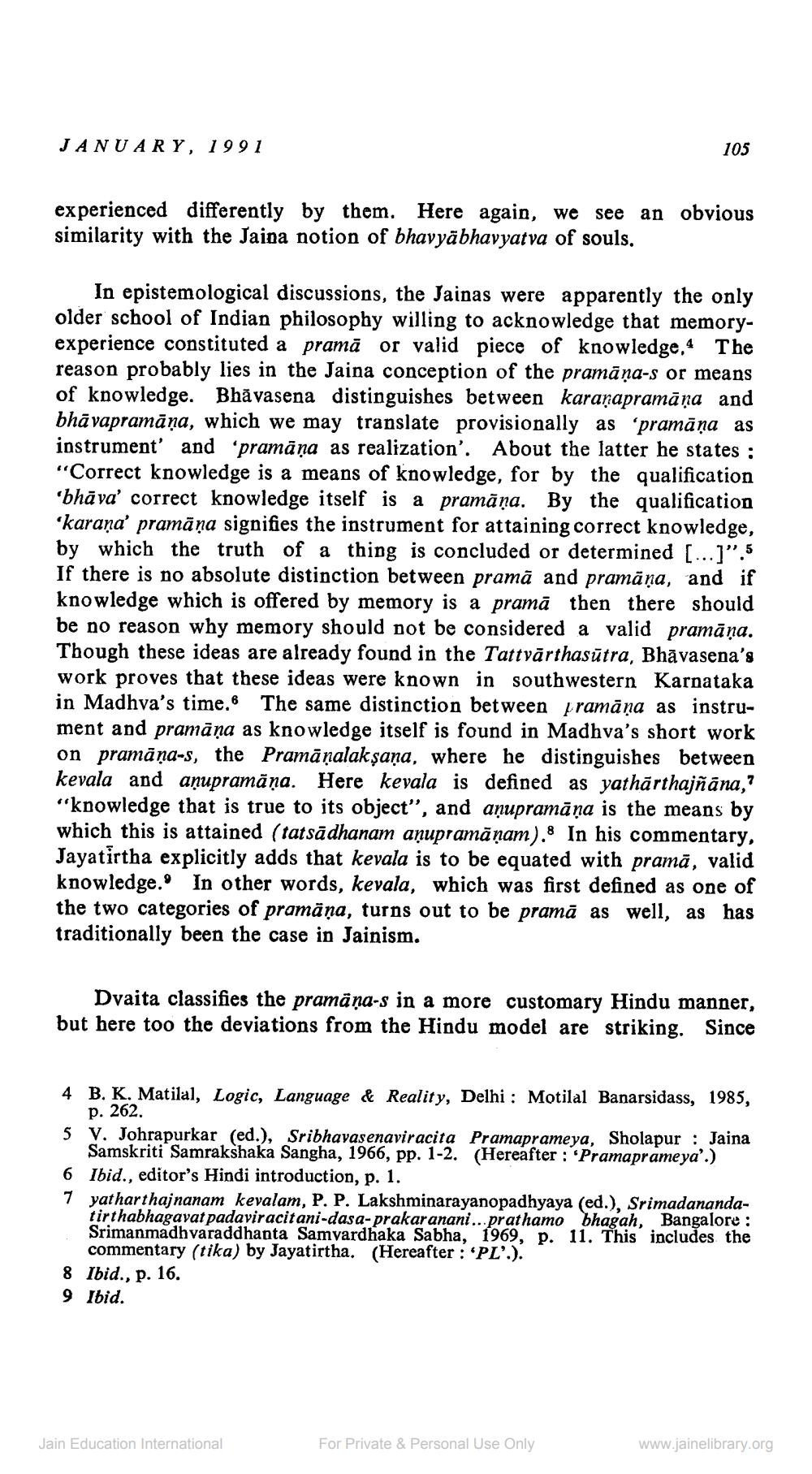Book Title: Jain Journal 1991 01 Author(s): Jain Bhawan Publication Publisher: Jain Bhawan Publication View full book textPage 7
________________ JANUARY, 1991 experienced differently by them. Here again, we see similarity with the Jaina notion of bhavyabhavyatva of souls. 105 In epistemological discussions, the Jainas were apparently the only older school of Indian philosophy willing to acknowledge that memoryexperience constituted a pramā or valid piece of knowledge, The reason probably lies in the Jaina conception of the pramāṇa-s or means of knowledge. Bhavasena distinguishes between karanapramāņa and bhāvapramāṇa, which we may translate provisionally as 'pramāņa as instrument' and 'pramāņa as realization'. About the latter he states: "Correct knowledge is a means of knowledge, for by the qualification 'bhava' correct knowledge itself is a pramāṇa. By the qualification 'karaṇa' pramāņa signifies the instrument for attaining correct knowledge, by which the truth of a thing is concluded or determined [...]".5 If there is no absolute distinction between prama and pramāṇa, and if knowledge which is offered by memory is a prama then there should be no reason why memory should not be considered a valid pramāņa. Though these ideas are already found in the Tattvärthasutra, Bhāvasena's work proves that these ideas were known in southwestern Karnataka in Madhva's time." The same distinction between pramāņa as instrument and pramāņa as knowledge itself is found in Madhva's short work on pramāṇa-s, the Pramanalakṣaṇa, where he distinguishes between kevala and aṇupramana. Here kevala is defined as yathārthajñāna," "knowledge that is true to its object", and aṇupramana is the means by which this is attained (tatsādhanam aṇupramāṇam).8 In his commentary, Jayatirtha explicitly adds that kevala is to be equated with pramā, valid knowledge. In other words, kevala, which was first defined as one of the two categories of pramāṇa, turns out to be prama as well, as has traditionally been the case in Jainism. an obvious Dvaita classifies the pramäṇa-s in a more customary Hindu manner, but here too the deviations from the Hindu model are striking. Since 4 B. K. Matilal, Logic, Language & Reality, Delhi: Motilal Banarsidass, 1985, p. 262. 5 V. Johrapurkar (ed.), Sribhavasenaviracita Pramaprameya, Sholapur Jaina Samskriti Samrakshaka Sangha, 1966, pp. 1-2. (Hereafter: Pramaprameya'.) 6 Ibid., editor's Hindi introduction, p. 1. Jain Education International 7 yatharthajnanam kevalam, P. P. Lakshminarayanopadhyaya (ed.), Srimadanandatirthabhagavat padavir acit ani-dasa-prakaranani...prathamo bhagah, Bangalore: Srimanmadhvaraddhanta Samvardhaka Sabha, 1969, p. 11. This includes the commentary (tika) by Jayatirtha. (Hereafter: 'PL'.). 8 Ibid., p. 16. 9 Ibid. For Private & Personal Use Only www.jainelibrary.orgPage Navigation
1 ... 5 6 7 8 9 10 11 12 13 14 15 16 17 18 19 20 21 22 23 24 25 26 27 28 29 30 31 32 33 34 35 36 37 38 39 40 41 42 43 44 45 46 47
